Abstract:
This study aims to understand the cost-effectiveness of health expenditures and explore why some countries have low expenses but better health outcomes, while others spend more but have underdeveloped healthcare systems. It analyzes income and health expenditures in developed and developing countries using existing literature and data analysis. The findings highlight the need for tailored policies, with developed countries focusing on cost increases and developing countries improving available healthcare services. This research provides insights for future studies and policy development, emphasizing the disparities in health expenditures between developing and developed countries.
Key Words:
Cost-effectiveness, Health Expenditures, Developing Countries, Developed Countries
JEL Classification:
Introduction
Global health spending has been increasing day by day. The pace varies from low to middle-income countries where health expenses are different (government, private or taking financial aid). Health Expenditure has been raised to 6% from 4% in developed countries according to the report of the World Health Organization (WHO, 2017). Middle-income countries referred to as developing countries are relying upon the external aid the developed countries give to spend on the health sector. The 2016 report of the World Health Organization (2000-2016) claims a specific change in the trend of health spending. The increased need for external aid resulted in the reduction of funding within the country from various sectors to cater for the issues (WHO, 2016).
Globally, there are eight major millennium-developed goals three of which were associated with the health sector. These goals were established in order to cater for the ongoing health issues, the poor countries of the world are facing causing a great disaster in overall health. Current trends revealed that is available international support in the form of financial aid still some poor countries are unable to achieve their goal. An ongoing debate highlighted that the health sector is ineligible to fulfil the demands of delivering quality health to the needed population.
Certain suggestions highlighted that if the healthcare sector falls short to fulfill basic requirements such as healthcare finance, labour, and medicine supply. Whereas the developed economies have various solutions such as the availability of health-related treatments at reduced prices with an intensive increase in resources. Considering all these circumstances the progress of health is slow. Based on these findings the concern about health care has increased because of its ongoing requirements as this step would be helpful in achieving life goals. These goals were later transformed into Sustainable development goals (SDG) where the third goal is solely focusing on health.
According to a Survey report by NHA (National health accounts, 2014; Cooper, 2018), health-related expenses were unequal around the globe. The US has been seen as spending more on health-related issues. On the other hand, European countries spent a large investment in the health sector. The South-Asian countries spend 2% in the health sector. African population spend 1%. Recent data by the World health organization (WHO, 2022) revealed that spending on health has increased by 6% across the globe. It was noted that health spending was 9 trillion in 2020 with a GDP of 10.8% but the income group was highly unequal. The 6% the increase was just by the US which is the biggest health spender. The report given by WHO (World health organization) also disclosed the fact that 4 countries were labelled as low-income, 11 were middle income and 29 were high-income countries (WHO, 2020).
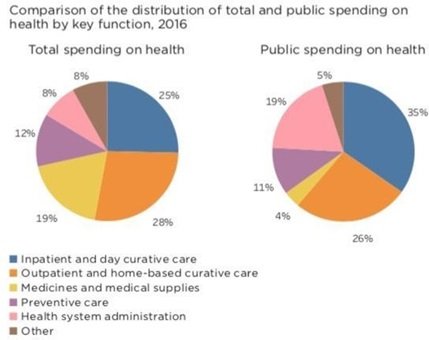
A study by WHO also reported 80% of
global spending is on health (WHO, 2016). Health
outcomes depend on health spending that is the reason. The more a country
spends on the health sector the
better results it would get regarding health. It has also been indicated that some countries spend less on health but
still have better outcomes it is because they have already upgraded their health sector. It is a serious constraint
for developing countries to address
these issues. This is a reason a need for the present study was observed. The
study would highlight various possible
determinants such as the role of income and other variables.
Objectives of the Study
The objective of the study is to grasp the dynamics of knowledge regarding the cost-effectiveness of health Expenditures and demonstrate the reasons why some countries have low expenses and better health Expenditures while the rest of the countries have spent more but still their health sector is underdeveloped. The aim of the study is to examine the income and health Expenditures in developing and developed countries. A dispersion in health Expenditures highlighted by Poullier demonstrated that 191 countries have been faced with unequal health spending in the health sector. Higher health expenses are linked with better health-related outcomes. Evans calculated the general health Expenditures of 191 countries from the year 1993 to 1997. His study relies on the effectiveness of health spending as an upward flux with respect to health Expenditures and later faced a downward flux. The researcher opted for this area of research considering it a gap area as the study of Evan showed a number of studies on this topic are less in number. This study would be helpful in developing strategies to cater for health-related issues. The main area of the study would emphasize the role of cost-effectiveness in health outcomes. Some other factors are also playing an important role in health care services. This study would try to cover all other aspects of cost-effectiveness in health Expenditures such as the role of income, organizations, technology, insurance and preventive measures such as education.
Importance of Study
The study emphasizes identifying the health expenses based on existing literature in order to carry out an Analysis of the obtained data to evaluate possible differences between the data of developed and developing countries. This study would be helpful in future for the researchers who wanted to inculcate more findings in this specific area. The study will pave out ways to cater for health Expenditures as well as help in the development of certain policies.
Literature Review
A dispersion in health Expenditures is highlighted by Poullier et al., (2002) demonstrated that 191 countries have been faced with unequal health spending in the health sector. Higher health expenses are linked with better health-related outcomes. Evans et al., (2000) calculated the general health Expenditures of 191 countries from the year 1993 to 1997. His study relies on the effectiveness of health spending as an upward flux with respect to health Expenditures and later it faced a downward flux.
Nair & Karim (1993) highlighted the variation in utilizing health-related services where they identified various diseases common in women, especially during their reproductive ages. The data was collected from the Federal Bureau of Statistics 1982-83. The survey was beneficial in highlighting certain common diseases exhibited in individuals. Old women were seen as more prone to those diseases. Another important finding was the major reason for these illnesses in rural and urban areas. It was noted that the unsafe and bacterial water was the reason for these illnesses. Bad sanitation was somehow increasing the risk. It was because of a lack of education. The services provided by the government were not utilized properly Thus healthcare become costly because of not having a proper insurance system (Kelley, 2017).
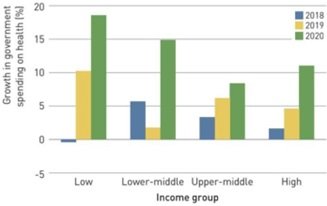
(World Health Organization, 2022). According to the 2020 data, an increase in government spending has been observed in the low-income group countries representing the fact that the less income a country had the more health Expenditures government would have to own.
The low-income countries have spent more on the health sector according to the report of the World Health Organization (WHO, 2022) the health spending indicators of developing countries were noted. Whereas an increase in health spending was also observed in developed countries from 2019 to 2020. Where some claim it was government beneficence during Covid- 19, 2020 crisis.
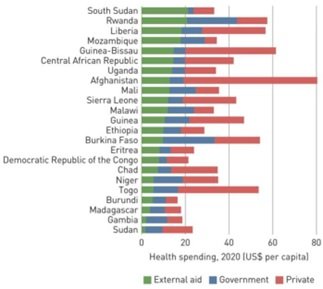
Figure3
Source: (World Health Organization, 2022).
The above representation highlights the percentage of financial aid, government and the private sector in the improvement of the health sector. The external aid is reduced by the percentage that makes some of the country’s poorest.
External aid was seen as a dominant funding level that plays a crucial role in the health sector of poor-income areas or countries. The report WHO highlighted 29% of spending on external aid in the health sector (WHO, 2020). The noticeable thing was the reduction in government spending and an increase in taking external aid.
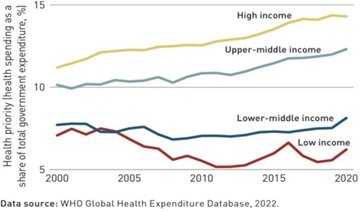
Source: (World Health Organization Global Expenditure Database, 2022).
World Health Organization report analyzed government spending on social programs and the educational sector. The list of benefits was made that identifies individuals in need such as disability, child support and sickness.
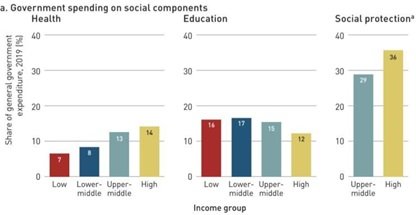
Source: (World Health Organization, 2020)
The gap areas highlighted are income and technology which plays a crucial role in health expenses. It is not easy for a developing country to spend more on buying technology without an expansion in income. Also, it is not possible to increase per Capita because of new technology. Existing studies focus on education as a significant contributor. Education would be a helpful tool in the coming era because it would surely be a helpful tool to promote stability.
The aim of the current paper is to make a strong contribution to the existing literature by investigating various health sector determinants. World Health Organization (WHO, 2020) records on the health sector in developing and developed countries were taken into account to rely on an authentic source that could help the researcher to produce reliable results. Literature findings highlighted that income, technology and insurance play a crucial role in the health sector growth. The study would derive the relation of these factors by differentiating the data of developed and developing countries using the static and dynamic model of economics.
Data Source, Methodology & Analysis
From the foundation of experimental research, the researcher utilized meta-analysis as a technique as it is the most used technique in research (Waldorf & Byrun 2005; Weichselbaumer & Winter-Ebmer 2005). The meta-analysis technique was utilized to deal with vast empirical studies having contradicting findings. To proceed with the meta-analysis the researcher utilized a systematic method to collect various papers on the topic understudy. There are certain advantages of meta-analysis in the literature review (Stanley, 2013).
It allows a quantitative assessment of the already existing data that helps to get a clear picture of the topic understudy. Secondly, meta-analysis help in studying variations of analysis in the existing finding such as the analysis method applied, the sample collected, the variables, and the demographics. This enables the researcher to identify the merits and demerits of the study keeping in view the country-specific contexts.
Selection of the Studies
To proceed with the meta-analysis, the first step taken was constructing the mind map of the meta-data. The aim was to address original papers that fit with the current topic. The researcher utilized Stanley et al., (2013) strategy of meta-analysis where two stages of the meta-analysis were utilized in the current paper. The preliminary stage was to collect relevant databases the second stage was to check the references in the existing literature to generate findings based on that data. The data was collected from 1993 to 2022, where few studies were quoted using meta-analysis technique while the rest of the results were generated from the recent data from different reports by World Health Organization’s global health database and World Development Indicators Statistics were consulted to derive the best findings and make possible recommendations.
Econometric Model
The macro expenditure highlighted the spending behaviour of some of the countries. One of the theories resembles this context focusing on the fact that health spending behaviour is not because of cause and effect but later technology and medicine would take a higher side. On the other hand, if the patient has been given an improper treatment there would be a need for more reports to confirm the diagnosis of the disease which would be more expensive than the previous general treatment. Also, the doctor would prescribe more drugs that would be costly. Secondly, the countries with older populations are high in number than the young population would have more health-related needs whereas the countries with more young generations would have different statistics. This was an important reason to differentiate the developing and the developed countries. Two models were utilized based on the idea of the study described next:
Econometric Model
The macro expenditure highlighted the spending behaviour of some of the countries. One of the theories resembles this context focusing on the fact that health spending behaviour is not because of cause and effect but later technology and medicine would take a higher side. On the other hand, if the patient has been given an improper treatment there would be a need for more reports to confirm the diagnosis of the disease which would be more expensive than the previous general treatment. Also, the doctor would prescribe more drugs that would be costly. Secondly, the countries with older populations are high in number than the young population would have more health-related needs whereas the countries with more young generations would have different statistics. This was an important reason to differentiate the developing and the developed countries. Two models were utilized based on the idea of the study described next:
Static Model: Dependent Variable: Health Expenses
In (HEPPPit) = ?it + ?1ln(GDPit) + ?2ln(GEit) + ?3RDit + ?4PRIEDUit + ?5SSit + ?6PRIV INSit + ?7GFCFit + ?8PGit + sit (i)
This
model refers to health expenses as Dependent Variable.
The major aim for using this as a dependent variable is the
measurement of health spending factors that can only be measured indirectly. Also, the health care needs are different
which is the reason this model was
constructed (already been utilized in a study done by). The overall model would
be helpful to determine the importance of the variables under study.
In the above equation,
t= the time duration (2017-2022), HE stands for health expenditures, GE is known as the
effectiveness of government, GDP is the gross domestic product, RD is the development of the research,
SS stands for social security
whereas PG is the growth
of population, and INS stands for insurance.
Dynamic Model: Dependent Variable: Health Expenses
ln(HEPPPit) = ?it + ?1ln(GDPit) + ?2ln(GEit) + ?3RDit + ?4PRIEDUit + ?5SSit +?6PRIV INSit +?7GFCFit + ?8PGit +ln(HEPPPit?1)+ sit (ii)
The dynamic association has also been specified. In the above equation, t= the time duration (2017-2022), HE stands for health expenditures, GE is known as the effectiveness of government, GDP is the gross domestic product, RD is the development of the research, SS stands for social security whereas PG is the growth of population, and INS stands for insurance.
Findings of the Study Descriptive Statistics Table 1
|
Variables |
Symbol |
Mean |
Max. |
Min. |
SD |
Source |
|
Health Expenditures |
ln( HEPPP ) |
6.94 |
9.14 |
1.27 |
1.40 |
WDI |
|
Per Capita |
PG |
1.36 |
60.64 |
-3.82 |
1.87 |
WDI |
|
Population Growth |
PRIEDU |
78.14 |
195.35 |
14.09 |
21.83 |
WDI |
|
Research Development |
RD |
5.31 |
475.66 |
0.005 |
47.47 |
WDI |
|
GDP |
ln(GDP ) |
7.23 |
11.62 |
1.85 |
1.57 |
WDI |
|
Gross Capital |
GFCF |
21.82 |
219.06 |
-2.42 |
10.44 |
WDI |
|
Effectiveness
of Government |
ln(GE) |
1.35 |
1.86 |
0.56 |
0.29 |
WDI |
|
Social Security |
SS |
45.83 |
99.02 |
0.50 |
32.22 |
WHO |
|
Insurance |
PRIVINS |
14.72 |
87.63 |
0.5 |
15.69 |
WHO |
Table 1.
Note: Max. = maximum, Min = Minimum, SD= standard deviation, Time Period= 2017-2022, WDI= World Development indicators, WHO= World health Organization.
Table 1 represents descriptive statistics of the present study focusing on the econometric model established under this study. The data is collected from two main sources that are WHO and WDI under the time duration of 2017-2022.
Regression Analysis
Model: HEPPP = ?0 + ?1ln(GDP ) + ?2ln(GE) + ?3RD + ?4PRIEDU + ?5SS +
?6PRIV INS + ?7GFCF + ?8PG + ?9DUMMY + s
Table 2
|
Variables |
Regression |
|
ln(GDP) |
877.28???(83.810) |
|
ln(GE) |
- 182.88???(386.626) |
|
RD |
547.52???(56.967) |
|
PRIEDU |
-1.347
(3.421) |
|
SS |
-7.36???(1.946) |
|
PRIVINS |
1.46
(3.555) |
|
GFCF |
-11.26???(4.864) |
|
PG |
162.15???(46.94) |
|
DUMMY |
-583.46???(194.88) |
Econometric Model Table 3
|
Variables Dep. Var: ln(HEPPP ) |
Static Model; Fixed
Effect Developed Countries Developing Countries |
Dynamic Model Developed Countries Developing Countries |
||
|
ln(GDP ) |
1.826???(0.813) |
1.895???(0.085) |
0.383??(0.188) |
0.047(0.098) |
|
ln(GE) |
-0.635??(0.273) |
0.630???(0.218) |
-0.431(0.441) |
0.819??(0.401) |
|
RD |
0.140???(0.031) |
0.193???(0.042) |
0.076?(0.454) |
0.086(0.960) |
|
PRIEDU |
0.001(0.001) |
0.000(0.001) |
-0.008?(0.004) |
0.003??(0.002) |
|
SS |
-0.005???(0.001) |
-0.004???(0.001) |
-0.009??(0.004) |
0.000(0.003) |
|
PRIVINS |
0.004???(0.001) |
-0.003?(0.001) |
-0.031??(0.015) |
-0.001(0.005) |
|
GFCF |
-0.023???(0.002) |
-0.004(0.003) |
0.004(0.004) |
0.006(0.006) |
|
PG |
-0.128(0.195) |
-0.070?(0.041) |
0.072(0.082) |
0.009(0.680) |
|
ln(HEPPP ).L1. |
|
|
0.830***(0.097) |
0.789???(0.091) |
|
F-Statistics |
148.06 |
143.08 |
|
|
|
R-Square |
0.892 |
0.894 |
|
|
|
Prob >F |
0.000 |
0.000 |
|
|
|
Wald Chi2 |
|
|
3242.77 |
1839.71 |
|
Prob >Chi |
|
|
0.000 |
0.000 |
|
AR(1) |
|
|
0.005 |
0.041 |
|
AR(2) |
|
|
0.455 |
0.687 |
|
Hansen Test |
|
|
1 |
0.996 |
|
???p<0.001, ???p<0.05, ?p<0.1, standard error in parentheses |
||||
Table 3 shows the results of the econometric model. Where there is a separate representation of the static and dynamic model is given according to the source (Fatima, 2020).
Conclusion
Our Globe has been faced with so many challenges, the only difference is the Nature of that challenge according to the area. It has been noted that health has been given importance in the sustainable development goals but still, some parts of the world are unable to fulfil this most important need because of so many reasons. These reasons vary from developed to developing countries. The third sustainable development goal (SDG) aims to focus on health as the rest of the goals are associated with it. Countries are trying to improve the outcome by increasing expenditures. Some are efficient while some are not. Based on these reasons the present paper focuses on highlighting the differences in health Expenditures in developing and developed countries.
The study was carried out on two data sets each having five countries in it to derive the major difference between developing and developed countries according to WHO (World health organization data). A significant difference in the expenditures has been noted the two data sets were non-comparable. The same variables vary in the two data sets because of other conditions. The most prominent role was seen in the Income in Health Expenditures. In the findings, the developed countries had lesser expenditure because of their government whereas the developing countries failed to reach the desired level. The same finding was seen with regard to the level of education. The developed countries had better healthcare units because of astonishing discoveries in science and technology. Also, their health-insured system was seen as beneficial. On the contrary, developing countries don’t even have insurance companies for health care units which act as an agent.
Policy Implications
In order to cater for health-related issues it is
Important for the government to revamp the health-related issues faced by the world. After reviewing the issues and noting down the details the policies could be devised based on the highlighted issues. The designed policies would be administered both in rural and urban areas so that associated risks could be reduced. There are also important findings here that emphasize the idea that the policies could be designed differently for developing and developed countries. Such as developed countries could focus on the increased cause whereas developing countries would only be improved if their available health services should be improved to a minimum. People would be provided with an opportunity to have insurance where they can take treatment if their monthly or yearly income could not afford their health domain.
References
- Batbold, O., Banzragch, T., Davaajargal, D., & Pu, C. (2021). Crowding-Out Effect of Out-of-Pocket Health Expenditures on Consumption Among Households in Mongolia. International Journal of Health Policy and Management, 11(9), 1874– 1882.
- Benli, M. (2022). Carbon Emission as a Determinant of Health Expenditures. Sosyal Bilimler Araştırma Derigsi, 11(2), 250-257.
- Cooper, J. (2018). UK Health accounts: 2015. Statistical Bulletin. Office for National Statistics.
- Evans, D. B., Tandon, A., Murray, C. J., & Lauer, J. A. (2000). The comparative efficiency of national health systems in producing health: an analysis of 191 countries. Geneva: World Health Organization.
- Kelly, M. (2017). Health capital accumulation, health insurance, and aggregate outcomes: A neoclassical approach. Journal of Macroeconomics, 52, 1–22.
- Limaye, V. S., Max, W., Constible, J., & Knowlton, K. (2019). Estimating the Health-Related Costs of 10 Climate- Sensitive U.S. Events During 2012. GeoHealth, 3(9), 245–265.
- Nair, C., & Karim, R. (1993). An overview of health care systems: Canada and selected OECD countries. PubMed, 5(3), 259–279.
- Poullier, J. P., Hernandez, P., Kawabata, K., & Savedoff, W. D. (2002). Patterns of global health expenditures: results for 191 countries. Geneva: World Health Organization.
- Stanley, T. D., Doucouliagos, H., Giles, M., Heckemeyer, J. H., Johnston, R. J., Laroche, P., Nelson, J. P., Paldam, M., Poot, J., Pugh, G., Rosenberger, R. S., & Rost, K. (2013). META-ANALYSIS OF ECONOMICS RESEARCH REPORTING GUIDELINES. Journal of Economic Surveys, 27(2), 390–394.
- Waldorf, B., & Byun, P. (2005). Meta-analysis of the impact of age structure on fertility. Journal of Population Economics, 18(1), 15–40.
- Weichselbaumer, D., & Winter-Ebmer, R. (2005). A Meta-Analysis of the International Gender Wage Gap. Journal of Economic Surveys, 19(3), 479–511.
- World Health Organization. (2020). Health expenditure per capita and in relation to GDP.
Cite this article
-
APA : Akhtar, S., Hameed, G., & Rabbani, S. A. (2023). Income-Based Inequalities and Health Expenditures in Developing & Developed Countries. Global Economics Review, VIII(I), 186-195. https://doi.org/10.31703/ger.2023(VIII-I).17
-
CHICAGO : Akhtar, Saima, Gulnaz Hameed, and Saad Ali Rabbani. 2023. "Income-Based Inequalities and Health Expenditures in Developing & Developed Countries." Global Economics Review, VIII (I): 186-195 doi: 10.31703/ger.2023(VIII-I).17
-
HARVARD : AKHTAR, S., HAMEED, G. & RABBANI, S. A. 2023. Income-Based Inequalities and Health Expenditures in Developing & Developed Countries. Global Economics Review, VIII, 186-195.
-
MHRA : Akhtar, Saima, Gulnaz Hameed, and Saad Ali Rabbani. 2023. "Income-Based Inequalities and Health Expenditures in Developing & Developed Countries." Global Economics Review, VIII: 186-195
-
MLA : Akhtar, Saima, Gulnaz Hameed, and Saad Ali Rabbani. "Income-Based Inequalities and Health Expenditures in Developing & Developed Countries." Global Economics Review, VIII.I (2023): 186-195 Print.
-
OXFORD : Akhtar, Saima, Hameed, Gulnaz, and Rabbani, Saad Ali (2023), "Income-Based Inequalities and Health Expenditures in Developing & Developed Countries", Global Economics Review, VIII (I), 186-195
-
TURABIAN : Akhtar, Saima, Gulnaz Hameed, and Saad Ali Rabbani. "Income-Based Inequalities and Health Expenditures in Developing & Developed Countries." Global Economics Review VIII, no. I (2023): 186-195. https://doi.org/10.31703/ger.2023(VIII-I).17
